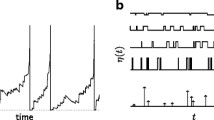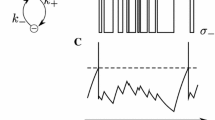Abstract
We develop theory and numerical methods for computing the most likely subthreshold voltage path of a noisy integrate-and-fire (IF) neuron, given observations of the neuron’s superthreshold spiking activity. This optimal voltage path satisfies a second-order ordinary differential (Euler-Lagrange) equation which may be solved analytically in a number of special cases, and which may be solved numerically in general via a simple “shooting” algorithm. Our results are applicable for both linear and nonlinear subthreshold dynamics, and in certain cases may be extended to correlated subthreshold noise sources. We also show how this optimal voltage may be used to obtain approximations to (1) the likelihood that an IF cell with a given set of parameters was responsible for the observed spike train; and (2) the instantaneous firing rate and interspike interval distribution of a given noisy IF cell. The latter probability approximations are based on the classical Freidlin-Wentzell theory of large deviations principles for stochastic differential equations. We close by comparing this most likely voltage path to the true observed subthreshold voltage trace in a case when intracellular voltage recordings are available in vitro.
Similar content being viewed by others
References
Badel L, Richardson M, Gerstner W (2005) Dependence of the spike-triggered average voltage on membrane response properties. Neurocomputing, In press.
Bellman R (1957) Dynamic Programming. Princeton University Press.
Brown E, Kass R, Mitra, P. (2004) Multiple neural spike train data analysis: state-of-the-art and future challenges. Nature Neurosci. 7: 456–461.
Brunel, N. Latham, P (2003) Firing rate of the noisy quadratic integrate-and-fire neuron. Neural Comput. 15: 2281–2306.
Burkitt A, Clark G (1999) Analysis of integrate-and-fire neurons: Synchronization of synaptic input and spike output. Neural Comput. 11: 871–901.
Cover T, Thomas J (1991). Elements of Information Theory. Wiley, New York.
Dembo A, Zeitouni O (1993). Large Deviations Techniques and Applications. Springer, New York.
Ermentrout G, Kopell N (1986) Parabolic bursting in an excitable system coupled with a slow oscillation. SIAM J. Appl. Math 2: 233–253.
Fourcaud N, Brunel N (2002) Dynamics of the firing probability of noisy integrate-and-fire neurons. Neural Comput. 14: 2057–2110.
Freidlin M, Wentzell A (1984) Random Perturbations of Dynamical Systems.Springer-Verlag.
Gerstner W, Kistler W (2002) Spiking Neuron Models: Single Neurons, Populations, Plasticity. Cambridge University Press.
Hansel D, Mato G (2003) Asynchronous states and the emergence of synchrony in large networks of interacting excitatory and inhibitory neurons. Neural Comput. 15: 1–56.
Hida T (1980) Brownian Motion. Springer-Verlag, New York.
Jeffrey A, Zwillinger D eds. (2000) Gradshteyn and Ryzhik’s Table of Integrals, Series, and Products. 6th edn. Academic Press.
Jolivet R, Lewis T, Gerstner W (2004) Generalized integrate-and-fire models of neuronal activity approximate spike trains of a detailed model to a high degree of accuracy. J. Neurophysiology, 92: 959–976.
Karatzas I, Shreve S (1997) Brownian Motion and Stochastic Calculus. Springer.
Karlin S, Taylor H (1981) A Second Course in Stochastic Processes. Academic Press, New York.
Mainen Z, Sejnowski T (1995) Reliability of spike timing in neocortical neurons. Science, 268: 1503–1506.
Neal R, Beal M, Roweis S (2003) Inferring state sequences for non-linear systems with embedded hidden Markov models. NIPS, 16.
Paninski L (2004) Maximum likelihood estimation of cascade point-process neural encoding models. Network: Comput. Neural Sys. 15: 243–262.
Paninski L (2005) The spike-triggered average of the integrate-and-fire cell driven by gaussian white noise. In press.
Paninski L, Haith A, Pillow J, Williams C (2005) Improved numerical methods for computing likelihoods in the stochastic integrate-and-fire model. Comp. Sys. Neur. ’05.
Paninski L, Lau B, Reyes A (2003) Noise-driven adaptation: in vitro and mathematical analysis. Neurocomputing 52: 877–883.
Paninski L, Pillow J, Simoncelli E (2004a) Comparing integrate-and-fire-like models estimated using intracellular and extracellular data. Neurocomputing, 65: 379–385.
Paninski L, Pillow J, Simoncelli E (2004b) Maximum likelihood estimation of a stochastic integrate-and-fire neural model. Neural Comput. 16: 2533–2561.
Plesser H, Gerstner W (2000) Noise in integrate-and-fire neurons: From stochastic input to escape rates. Neural Comput. 12: 367–384.
Press W, Teukolsky S, Vetterling W, Flannery B (1992). Numerical recipes in C. Cambridge University Press.
Rabiner, L (1989) A tutorial on hidden Markov models and selected applications in speech recognition. Proc. IEEE, 77: 257–286.
Stevens C, Zador A, (1996) When is an integrate-and-fire neuron like a Poisson neuron? NIPS 8: 103–109.
Stevens C, Zador A (1998) Novel integrate-and-fire-like model of repetitive firing in cortical neurons. Proc. 5th Joint Symp. Neural Comput. UCSD.
Vinter R (2000) Optimal Control. Birkhauser.
Author information
Authors and Affiliations
Corresponding author
Additional information
Action Editor: Peter Latham
Rights and permissions
About this article
Cite this article
Paninski, L. The most likely voltage path and large deviations approximations for integrate-and-fire neurons. J Comput Neurosci 21, 71–87 (2006). https://doi.org/10.1007/s10827-006-7200-4
Received:
Revised:
Accepted:
Published:
Issue Date:
DOI: https://doi.org/10.1007/s10827-006-7200-4




